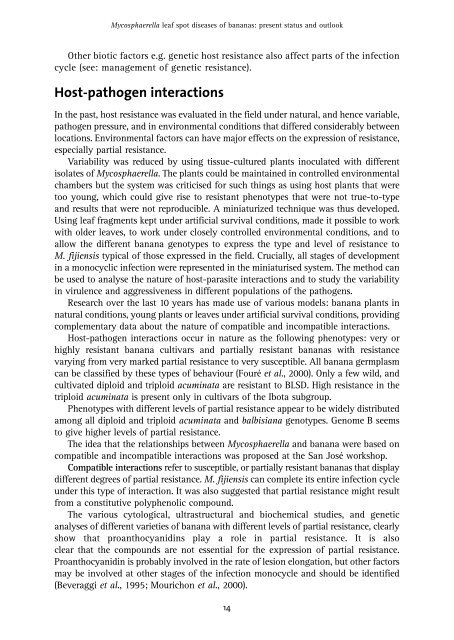Mycosphaerella leaf spot diseases of bananas - CBS
Mycosphaerella leaf spot diseases of bananas - CBS
Mycosphaerella leaf spot diseases of bananas - CBS
Create successful ePaper yourself
Turn your PDF publications into a flip-book with our unique Google optimized e-Paper software.
<strong>Mycosphaerella</strong> <strong>leaf</strong> <strong>spot</strong> <strong>diseases</strong> <strong>of</strong> <strong>bananas</strong>: present status and outlook<br />
Other biotic factors e.g. genetic host resistance also affect parts <strong>of</strong> the infection<br />
cycle (see: management <strong>of</strong> genetic resistance).<br />
Host-pathogen interactions<br />
In the past, host resistance was evaluated in the field under natural, and hence variable,<br />
pathogen pressure, and in environmental conditions that differed considerably between<br />
locations. Environmental factors can have major effects on the expression <strong>of</strong> resistance,<br />
especially partial resistance.<br />
Variability was reduced by using tissue-cultured plants inoculated with different<br />
isolates <strong>of</strong> <strong>Mycosphaerella</strong>. The plants could be maintained in controlled environmental<br />
chambers but the system was criticised for such things as using host plants that were<br />
too young, which could give rise to resistant phenotypes that were not true-to-type<br />
and results that were not reproducible. A miniaturized technique was thus developed.<br />
Using <strong>leaf</strong> fragments kept under artificial survival conditions, made it possible to work<br />
with older leaves, to work under closely controlled environmental conditions, and to<br />
allow the different banana genotypes to express the type and level <strong>of</strong> resistance to<br />
M. fijiensis typical <strong>of</strong> those expressed in the field. Crucially, all stages <strong>of</strong> development<br />
in a monocyclic infection were represented in the miniaturised system. The method can<br />
be used to analyse the nature <strong>of</strong> host-parasite interactions and to study the variability<br />
in virulence and aggressiveness in different populations <strong>of</strong> the pathogens.<br />
Research over the last 10 years has made use <strong>of</strong> various models: banana plants in<br />
natural conditions, young plants or leaves under artificial survival conditions, providing<br />
complementary data about the nature <strong>of</strong> compatible and incompatible interactions.<br />
Host-pathogen interactions occur in nature as the following phenotypes: very or<br />
highly resistant banana cultivars and partially resistant <strong>bananas</strong> with resistance<br />
varying from very marked partial resistance to very susceptible. All banana germplasm<br />
can be classified by these types <strong>of</strong> behaviour (Fouré et al., 2000). Only a few wild, and<br />
cultivated diploid and triploid acuminata are resistant to BLSD. High resistance in the<br />
triploid acuminata is present only in cultivars <strong>of</strong> the Ibota subgroup.<br />
Phenotypes with different levels <strong>of</strong> partial resistance appear to be widely distributed<br />
among all diploid and triploid acuminata and balbisiana genotypes. Genome B seems<br />
to give higher levels <strong>of</strong> partial resistance.<br />
The idea that the relationships between <strong>Mycosphaerella</strong> and banana were based on<br />
compatible and incompatible interactions was proposed at the San José workshop.<br />
Compatible interactions refer to susceptible, or partially resistant <strong>bananas</strong> that display<br />
different degrees <strong>of</strong> partial resistance. M. fijiensis can complete its entire infection cycle<br />
under this type <strong>of</strong> interaction. It was also suggested that partial resistance might result<br />
from a constitutive polyphenolic compound.<br />
The various cytological, ultrastructural and biochemical studies, and genetic<br />
analyses <strong>of</strong> different varieties <strong>of</strong> banana with different levels <strong>of</strong> partial resistance, clearly<br />
show that proanthocyanidins play a role in partial resistance. It is also<br />
clear that the compounds are not essential for the expression <strong>of</strong> partial resistance.<br />
Proanthocyanidin is probably involved in the rate <strong>of</strong> lesion elongation, but other factors<br />
may be involved at other stages <strong>of</strong> the infection monocycle and should be identified<br />
(Beveraggi et al., 1995; Mourichon et al., 2000).<br />
14

















